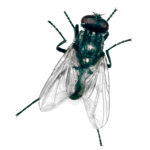House Fly
Musca domestica

What are houseflies?
House flies are a well-known and common insect species. They are prevalent on farms and in homes. Their presence transmits disease and tries the patience of most people.
House flies are small, two-winged insects. Their bodies are gray-colored and they have two velvety stripes, which are silver above and gold below. They measure approximately 1/4″-1/2″ long.
Can you tell me a bit about their biology?
Adult female flies begin laying eggs just a few days after hatching from their pupal stage. Over the course of their lifetime, flies usually lay 5 to 6 batches of 75-100 small, white, oval eggs. After 12 to 24 hours, the eggs hatch into larvae or, as they are more commonly known, maggots. These maggots are cream-colored and burrow into the material on which they are hatched. After 4 to 7 days, the larvae contract and harden into a shell in which the pupae form. Once the pupae emerge as flies, they can restart the mating and reproduction process within a few hours.
Flies have the ability to reproduce many young very quickly. Under ideal warm conditions, two life cycles may be completed within a month. If 75 to 100 eggs are yielded per egg deposit, one fly can produce at least 150 flies by the following month. Populations of flies are always highest during the early fall months. In some areas, populations may develop indoors throughout the winter.
Eggs are laid in warm, moist material. Examples are animal manure, human excrement, garbage, decaying vegetable material, and areas on the ground contaminated with these materials. The fact that flies are in such frequent contact with these materials make them health hazards. After flies have been around these materials, they very often will enter homes and taint your food, dishes, counters and living spaces with contaminants and diseases that cover their bodies and mouthparts.
Many people have heard stories about maggots getting into open wounds and wreaking havoc. Urban legend? Unfortunately not. Myiasis is an infection of fly larvae in animals that is very common in sheep, cattle, and deer. It can also happen to humans with ulcerated skin. An adult fly will lay eggs on a wound (a warm, moist place as described above), after which they hatch and burrow into the skin. This burrowing may cause boil-like lesions, or the maggots may wander through the body and cause damage to various organs. Intestinal myiasis occurs when humans ingest food containing the eggs of larvae.
What are their feeding habits?
Flies are attracted to a wide variety of food material. They have mouthparts that restrict them to consuming only liquids. To digest solid foods, they regurgitate saliva to liquefy the food, thereby making it easy to ingest and pass into the digestive track.
How about their behavior and habitat?
During daylight hours, flies can be found in a number of places indoors and outdoors. Indoors, they may be found resting on ceilings, floors, and walls. During the night hours, flies will rest on ceilings, electric wires, and light cords. Outdoors, plants, fences, wires, garbage, and the ground all provide suitable locations for houseflies. At night, flies rest chiefly on fences, electric wires, edges of buildings and on plants. In all situations, flies prefer to rest on corners and edges of surfaces, and on thin objects such as wires and strings.
How are they a health hazard?
Flies are an important health hazard not to be overlooked. To illustrate this point, they make cockroaches seem barely a health issue.
As mentioned earlier, flies transmit a whole host of diseases because they travel straight from filth into the living spaces of humans. Examples of these diseases are typhoid, dysentery, cholera, hookworm, tapeworm, bacillary, infantile diarrhea, roundworm, and whipworm. Pathogenic organisms are picked up from sources such as garbage, sewage, and other filth. Then, through their vomitus and feces, they transmit these organisms onto human and animal food and throughout living spaces.
